The Majestic Norbulingka Summer Palace: Where Tradition Meets Tranquility
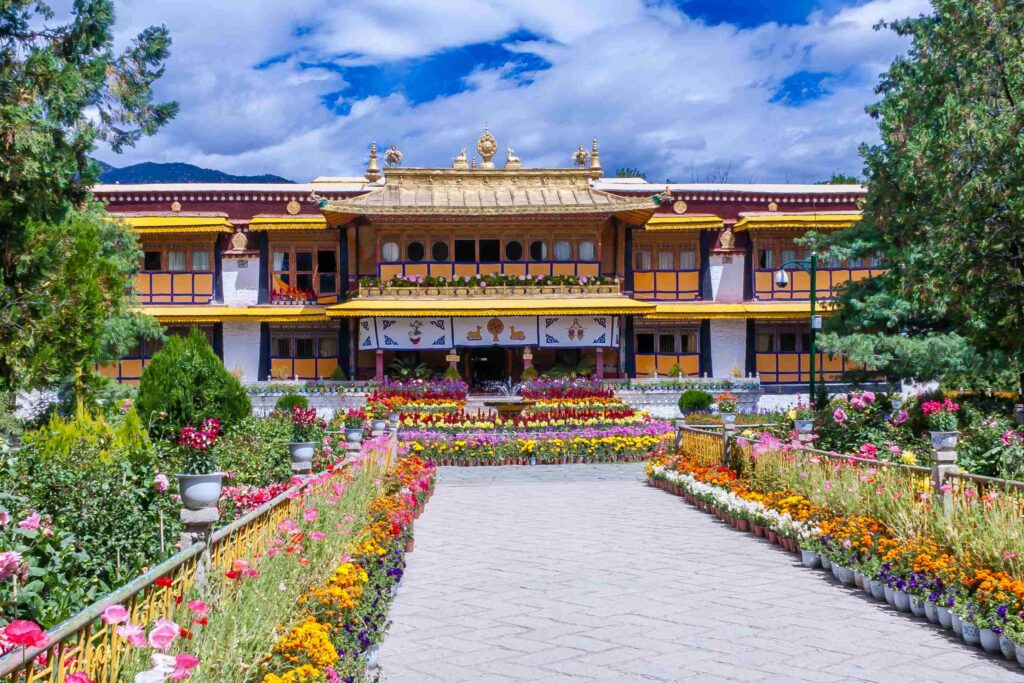
An Essential Guide to Visiting Norbulingka Summer Palace
Nestled in the heart of Lhasa, the Norbulingka Summer Palace stands as a serene oasis, inviting travelers to step into a world where nature, history, and spirituality intertwine. Often referred to as the “Park of Treasure,” this sprawling garden complex served as the summer retreat for the Dalai Lamas, offering a tranquil escape from the bustling life of the city. With its lush landscapes, stunning Tibetan architecture, and rich cultural heritage, Norbulingka is not just a historical site; it is a vibrant symbol of Tibetan identity and artistry.
Established in 1755 by the 7th Dalai Lama, Norbulingka’s expansive grounds encompass beautifully designed palaces, pavilions, and gardens that reflect the elegance of traditional Tibetan style. As you wander through its 360,000 square meters, you’ll discover exquisite murals, intricate sculptures, and serene water features that offer a glimpse into the spiritual life of the lamas who once roamed these grounds. Each corner of this magnificent site tells a story, from the opulent Potrang (palaces) to the peaceful meditation spots, making it a must-visit for anyone eager to understand the essence of Tibetan culture.
Visiting Norbulingka is more than just a sightseeing excursion; it’s an invitation to immerse yourself in the tranquility of this sacred space, where you can enjoy leisurely strolls amidst vibrant flowers, participate in local festivals, or simply sit and soak in the stunning surroundings. Whether you’re a history enthusiast, a nature lover, or someone seeking a peaceful retreat, Norbulingka promises an unforgettable experience that resonates long after you leave its enchanting grounds.
In This Guide
- An Essential Guide to Visiting Norbulingka Summer Palace
- The Rich History and Legends of Norbulingka Summer Palace
- Main Highlights: What You Absolutely Can’t Miss
- Planning Your Visit: A Practical Guide
- Tickets: Prices, Booking, and Tips
- How to Get There: A Complete Transportation Guide
- Local Cuisine and Accommodation Nearby
- Frequently Asked Questions
- Final Thoughts on Your Trip
The Rich History and Legends of Norbulingka Summer Palace
Nestled on the western edge of Lhasa, Norbulingka Summer Palace, meaning “Park of Treasure” in Tibetan, is a testament to the rich history and cultural significance of Tibet. This sprawling estate, which serves as the largest manmade garden in the Tibetan Autonomous Region, began its transformation into a royal palace in 1755 under the patronage of the 7th Dalai Lama, Kelsang Gyatso.
Initially, the site was a barren expanse overrun with weeds and wild animals, but its serene summer landscape captivated the 7th Dalai Lama, who sought refuge here to escape the heat of Lhasa. Recognizing its potential, he initiated the development of a beautiful park where he could conduct political affairs, meet dignitaries, and perform religious ceremonies. This marked the beginning of Norbulingka’s evolution into a summer retreat for the Dalai Lamas.
Throughout the years, subsequent Dalai Lamas expanded and embellished the palace. The 8th Dalai Lama further enhanced the grounds with palatial structures and gardens, establishing a complex that would eventually consist of multiple buildings and sprawling grounds. By the time the 14th Dalai Lama came to power, Norbulingka had grown to include over 374 rooms and a variety of architectural styles, blending traditional Tibetan design with elements from traditional Chinese gardens.
The layout of Norbulingka is thoughtfully organized into three primary sections: the forest area, the palace area, and the front area of the palaces. Visitors can wander through these beautifully arranged spaces, each adorned with colorful flora, intricate murals, and sacred Buddhist relics. The palaces within Norbulingka, such as Kelsang Potrang, Tsokyil Potrang, and Takten Migyur Potrang, offer a glimpse into the opulent lifestyle of the Dalai Lamas, housing various historical artifacts, religious texts, and stunning artworks.
In 1959, following the political upheaval in Tibet, Norbulingka was officially opened to the public, transforming from a royal residence into a museum and public park. This change allowed both locals and international visitors to appreciate its beauty and significance. Today, Norbulingka is not only a historical site but also a vibrant hub for cultural activities, including the famous Shoton Festival, where traditional Tibetan opera and other performances celebrate the rich cultural heritage of Tibet.
As you stroll through the gardens and palaces of Norbulingka, you are walking in the footsteps of history, where each stone and flower tells a story of faith, governance, and the enduring spirit of the Tibetan people. This tranquil oasis remains a profound reminder of the Dalai Lamas’ legacy and their deep connection to the land and its culture.
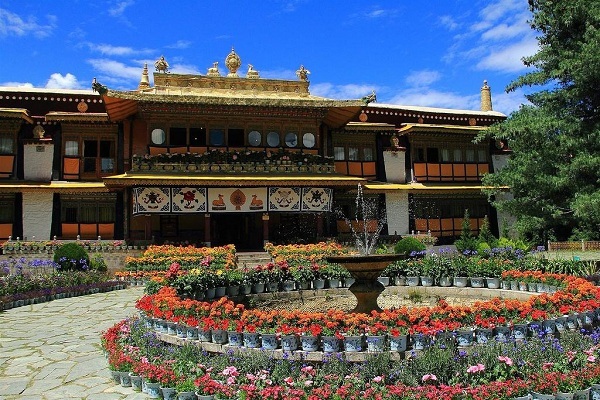
Norbulingka Summer Palace.
Main Highlights: What You Absolutely Can’t Miss
Norbulingka Summer Palace is a mesmerizing destination that offers an enchanting glimpse into Tibetan culture, history, and natural beauty. Here are the main highlights that you absolutely can’t miss when visiting this exquisite site:
1. The Majestic Potrangs
Norbulingka is home to three significant palaces, known as potrangs, each showcasing unique architectural styles and rich histories:
– Kelsang Potrang: This is the oldest palace, built under the reign of the 7th Dalai Lama. Its three stories include the Main Assembly Hall and chambers adorned with stunning murals depicting daily life in Tibet. The vibrant imagery of children playing is particularly rare and a delight to behold.
– Tyokyil Potrang: Nestled amid a serene lake, this picturesque pavilion, constructed by the 8th Dalai Lama, is a must-visit. The palace features a charming design with golden roofs and intricate Buddhist murals, creating a peaceful atmosphere perfect for reflection.
– Takten Migyur Potrang: Constructed by the 14th Dalai Lama in 1954, this is the largest and most elegant of the three. Its lavish design combines elements of a temple and a villa, and the murals on the second floor narrate Tibetan history through over 300 scenes.
2. Lush Gardens and Tranquil Walkways
Norbulingka is celebrated as the largest manmade garden in Tibet. Covering over 360,000 square meters, the gardens are meticulously landscaped with a stunning array of flowers and plants. As you stroll through the serene pathways, you’ll be enveloped by tranquility, making it an ideal spot for relaxation and contemplation.
3. Norbulingka Museum
Opened to the public in 1959, the museum within the palace complex houses an impressive collection of Tibetan artifacts, art, and historical relics. Here, you can discover the rich tapestry of Tibetan history, including exquisite Thangkas, ancient Buddhist texts, and artifacts gifted from various Chinese dynasties.
4. The Shoton Festival
If your visit coincides with the Shoton Festival, you’re in for a treat. Celebrated annually, this vibrant event brings together locals and tourists alike for a week of picnics, traditional Tibetan opera performances, and festive activities. The atmosphere is electric, filled with music, laughter, and the spirit of Tibetan culture.
5. Breathtaking Scenery and Photography Opportunities
Norbulingka is often referred to as a “Plateau Oxygen Bar” due to its stunning natural beauty and floral diversity. The picturesque landscapes, combined with the impressive architecture of the palaces, make for incredible photo opportunities. Don’t forget your camera to capture the breathtaking views and the serene ambiance.
6. Accessibility and Visitor Amenities
Conveniently located just southwest of the iconic Potala Palace, Norbulingka is easily accessible by public transport or on foot. Plan to spend 2-3 hours exploring the expansive grounds and visiting the palaces. There are also options for guided tours, and various activities like Tibetan tea tasting and cultural performances enhance your visit.
Conclusion
A visit to Norbulingka Summer Palace is a captivating journey through Tibetan history and culture. With its remarkable palaces, beautiful gardens, and vibrant festivals, this UNESCO World Heritage Site is a treasure trove of experiences that every traveler should explore. Whether you’re seeking tranquility, cultural enrichment, or simply a stunning backdrop for your photos, Norbulingka promises an unforgettable adventure.
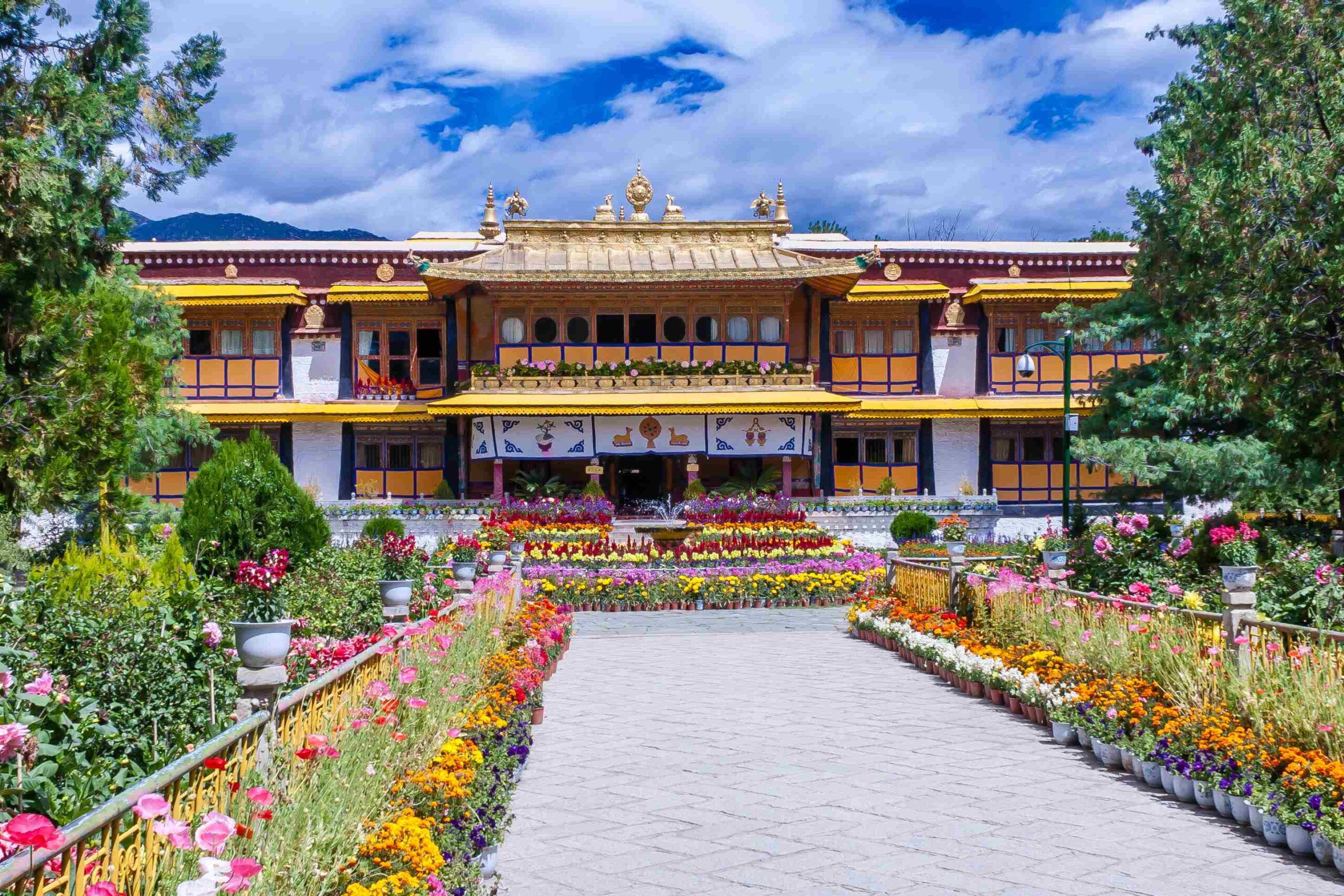
Norbulingka Summer Palace.
Planning Your Visit: A Practical Guide
Visiting Norbulingka Summer Palace is an enriching experience that combines stunning architecture, lush gardens, and deep cultural significance. Here’s a comprehensive guide to help you plan your visit to this remarkable site in Lhasa, Tibet.
Getting There
Norbulingka is conveniently located in the heart of Lhasa, making it easily accessible from various points in the city. Here are your options:
- Public Transport: Local buses, including routes 2, 14, and 24, frequently service the area.
- Walking: If you’re near notable landmarks like Potala Palace or Tibet Museum, a leisurely walk will take you to Norbulingka in about 20-30 minutes.
- Taxi or Pedicab: From farther destinations, such as Barkhor Street, consider taking a taxi or pedicab for a more comfortable journey.
Admission Fees
To enter Norbulingka, you’ll need to purchase a ticket, which costs 60 RMB. If you’re interested in visiting the zoo located within the grounds, there is an additional fee of 10 RMB.
Best Time to Visit
The ideal seasons to explore Norbulingka are during summer and autumn when the gardens are in full bloom and the weather is generally milder. If your visit coincides with the Shoton Festival (usually in late June to early July), you’ll have the opportunity to participate in vibrant festivities, including traditional Tibetan opera performances and community picnics.
Duration of Visit
Plan to spend 2 to 3 hours exploring the expansive grounds. The palace complex is vast, so you can choose to take a leisurely stroll or opt for a tourist bus tour offered for 20 RMB.
Highlights to Explore
-
Palaces and Gardens: Don’t miss the three main palaces—Kelsang Potrang, Tsokyil Potrang, and Takten Migyur Potrang. Each showcases unique architectural features and historical artifacts.
-
Murals and Artworks: Admire the stunning murals and Thangkas displayed throughout the palaces, which depict significant Buddhist themes and Tibetan culture.
-
Tyokyil Potrang: This picturesque pavilion surrounded by a lake is a must-see, featuring intricate designs and beautiful views.
-
Cultural Activities: Engage with various cultural activities offered at the palace, such as watching traditional Tibetan shows and tasting authentic Tibetan tea.
Photography Tips
Norbulingka is a photographer’s paradise, with its lush gardens and stunning architecture. Feel free to capture the beauty, but remember to ask for permission before photographing inside the Buddhist halls and palaces.
Preparing for Your Visit
- Dress Comfortably: As Lhasa is situated at an altitude of 3,650 meters, wear comfortable shoes and dress in layers to accommodate fluctuating temperatures.
- Stay Hydrated: The high altitude can be dehydrating, so make sure to drink plenty of water.
- Health Precautions: If you’re not acclimatized to the altitude, be aware of the symptoms of altitude sickness and take it slow.
Nearby Attractions
While you’re in the area, consider visiting other cultural landmarks:
- Potala Palace (2.5 km away)
- Jokhang Temple (4 km away)
- Barkhor Street (3.8 km away)
Conclusion
A visit to Norbulingka Summer Palace offers a unique glimpse into Tibetan culture and history, all set against a backdrop of stunning natural beauty. Plan your visit thoughtfully, and immerse yourself in the tranquility and charm of this historic site. Whether you’re wandering through the gardens or exploring the intricacies of the palaces, Norbulingka is sure to leave a lasting impression. Enjoy your journey!
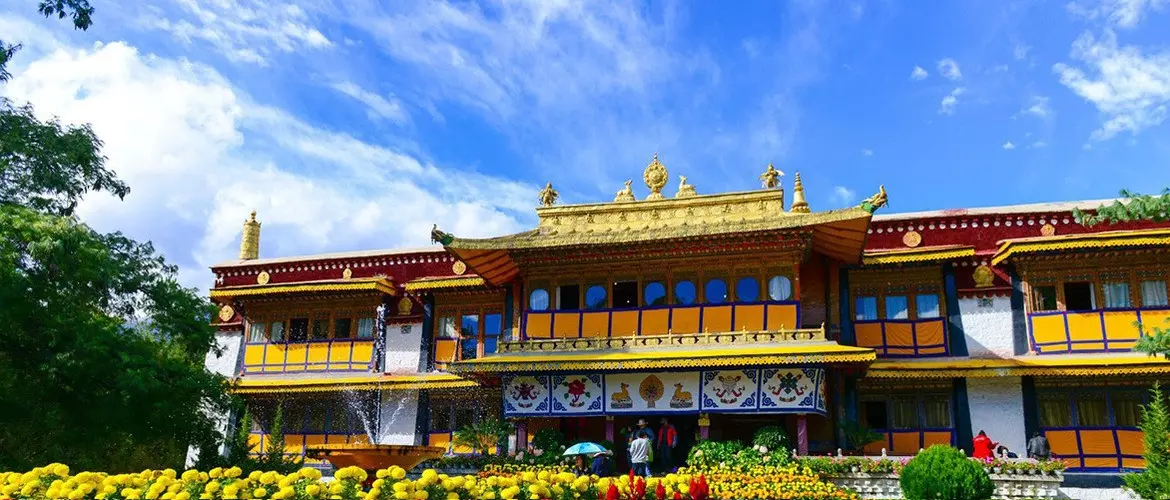
Norbulingka Summer Palace.
Tickets: Prices, Booking, and Tips
Visiting Norbulingka Summer Palace is a captivating experience that allows you to immerse yourself in the rich history and stunning beauty of Tibet. Here’s everything you need to know about tickets, prices, and tips for your visit.
Ticket Prices
- General Admission: The entry fee to Norbulingka is 60 RMB per person. This ticket grants you access to the expansive gardens and the remarkable palaces within the complex.
- Zoo Access: If you’re interested in visiting the only zoo in Lhasa located within the grounds, you can purchase an additional ticket for 10 RMB.
Booking Information
Tickets can be purchased at the entrance of Norbulingka. There is no need for advance booking, but arriving early is advisable, especially during peak tourist seasons or local festivals.
Duration of Visit
Plan to spend 2 to 3 hours exploring the vast area of Norbulingka. The gardens and palaces are spread over 360,000 square meters, so you may choose to focus on specific areas or take a guided bus tour around the park for 20 RMB per person, which is a great option for those who prefer a more leisurely exploration.
Tips for Your Visit
-
Best Time to Visit: The summer months, particularly during the Shoton Festival (usually in late June or early July), offer a vibrant atmosphere with various cultural activities, performances, and local picnics. This is a wonderful time to enjoy the lively ambiance of Norbulingka.
-
Activities: Engage in various activities while at the palace, such as watching traditional Tibetan opera performances, participating in local festivals, or simply savoring a cup of Tibetan tea in the serene surroundings.
-
Photography: Don’t forget your camera! Norbulingka is a treasure trove of beautiful scenery and intricate architecture. While taking photos inside Buddhist halls and palaces, remember to ask for permission first to respect the sacred atmosphere.
-
Nearby Attractions: Norbulingka is conveniently located near other significant sites like Potala Palace and Jokhang Temple. Consider planning your day to visit these landmarks as well, as they are within walking distance or a short taxi ride away.
Getting There
Norbulingka is easily accessible from various parts of Lhasa. Public buses No. 2, 14, and 24 travel to the palace, and walking from nearby attractions is also a pleasant option. If you’re traveling from farther locations like Barkhor Street, taxis or pedicabs are recommended.
By planning your visit to Norbulingka Summer Palace with these tips in mind, you’re sure to have a memorable experience in this tranquil and historic setting. Enjoy your journey through one of Tibet’s most beautiful cultural treasures!
How to Get There: A Complete Transportation Guide
Reaching Norbulingka Summer Palace is a delightful experience, as it is conveniently located in the heart of Lhasa, Tibet. This beautiful park, once the summer residence of the Dalai Lamas, is easily accessible via various modes of transportation. Here’s a comprehensive guide to help you navigate your way to this serene oasis.
Getting to Norbulingka
By Bus
Lhasa’s public bus system is a reliable and economical way to reach Norbulingka. Several bus routes service the area:
- Bus No. 2
- Bus No. 14
- Bus No. 24
These buses run frequently and can take you from various parts of the city directly to Norbulingka. Be sure to check the latest schedules and routes, as they may change.
On Foot
For those who enjoy walking, Norbulingka is within a reasonable distance from several major attractions in Lhasa. Here are some approximate distances:
- From Potala Palace: 2.5 km (about a 30-minute walk)
- From Jokhang Temple: 4 km (roughly a 50-minute walk)
- From Barkhor Street: 3.8 km (approximately a 45-minute walk)
Strolling through the city can be a pleasant way to take in the local culture and architecture, making your journey to Norbulingka all the more enjoyable.
By Taxi or Pedicab
If you prefer a faster option, taxis and pedicabs are readily available throughout Lhasa. A taxi ride from central locations like Barkhor Street or Potala Palace to Norbulingka is relatively inexpensive and should take around 10-15 minutes, depending on traffic.
Pedicabs, or cycle rickshaws, offer a unique and leisurely way to travel. While they may take slightly longer than a taxi, the experience can be quite charming as you navigate the streets of Lhasa.
Additional Transportation Tips
- Tickets: Entrance to Norbulingka is ¥60, and if you’re interested in visiting the nearby zoo, you can purchase an additional ticket for ¥10.
- Time Needed: Plan to spend 2-3 hours exploring the expansive grounds of Norbulingka. The gardens, palaces, and museums offer plenty to see and do.
- Accessibility: For those who may have difficulty walking long distances, consider taking the tourist bus that operates within the park for ¥20 per person.
Nearby Attractions
If time permits, you can easily combine your visit to Norbulingka with other nearby sites, such as:
- Potala Palace
- Jokhang Temple
- Barkhor Street
These attractions are not only close by but also represent the rich cultural tapestry of Lhasa, making them worthwhile stops on your journey.
Conclusion
Whether you choose to take a bus, walk, or hire a taxi, getting to Norbulingka Summer Palace is straightforward and part of the adventure of exploring Lhasa. Prepare to be enchanted by the tranquil beauty of this historic site and its surrounding gardens as you immerse yourself in the essence of Tibetan culture.

Norbulingka Summer Palace.
Local Cuisine and Accommodation Nearby
When visiting the serene Norbulingka Summer Palace, you’ll find yourself immersed in not only its historical beauty but also in the local culinary delights and comfortable accommodations that enhance your stay in Lhasa.
Local Cuisine
1. Tibetan Cuisine at Lhasa Kitchen
Just a short walk from the palace, Lhasa Kitchen offers a cozy atmosphere and a menu filled with traditional Tibetan dishes. Be sure to try their Momo (dumplings) and Thukpa (noodle soup) for a hearty meal. The restaurant prides itself on using local ingredients, ensuring an authentic taste of Tibet.
2. The Tibetan Secret
Known for its warm ambiance, The Tibetan Secret serves a delightful selection of Tibetan and Chinese fusion dishes. Their Yak Steak is a must-try, as is the Tibetan Butter Tea which is both invigorating and comforting after a day of exploring.
3. House of Shambhala
Located near the Barkhor Street, this charming eatery serves a variety of Tibetan and Indian dishes. Their Vegetable Curry and Tibetan Bread are favorites among locals and tourists alike. The rooftop terrace offers stunning views, making it a perfect spot for a leisurely meal after your visit to Norbulingka.
Accommodation Options
1. The Khangsar Hotel
Just a few minutes away from the palace, the Khangsar Hotel combines comfort with tradition. With its Tibetan-style decor and modern amenities, it provides a perfect base for exploring Lhasa. Guests rave about the friendly staff and the charming courtyard where you can unwind.
2. Yak Hotel
Located near the city center, Yak Hotel is a popular choice for travelers looking for a blend of comfort and convenience. The hotel offers clean and spacious rooms, and its restaurant serves a variety of Tibetan and Western dishes. It’s an ideal spot to relax after a day of sightseeing.
3. Tashi Choeta Hotel
For those seeking a more budget-friendly option, Tashi Choeta Hotel offers simple yet comfortable accommodations. Its proximity to Norbulingka makes it easy to visit the palace multiple times, and the friendly staff can assist with travel arrangements and local tips.
Conclusion
Exploring Norbulingka Summer Palace is not just about the breathtaking architecture and tranquil gardens; it’s also a chance to savor the unique flavors of Tibetan cuisine and enjoy a restful stay at nearby accommodations. Whether indulging in a warm bowl of Thukpa or retreating to a cozy hotel room, your experience in Lhasa will undoubtedly be enhanced by the local offerings.
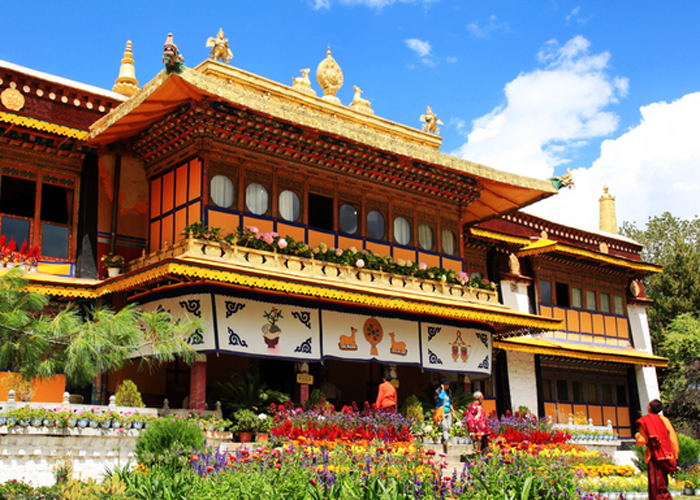
Norbulingka Summer Palace.
Frequently Asked Questions
Frequently Asked Questions about Norbulingka Summer Palace
1. What are the opening hours for Norbulingka Palace?
Norbulingka Summer Palace is typically open from 9:00 AM to 5:30 PM daily. However, it’s advisable to check for any changes in schedule, especially during local festivals or events.
2. How much does it cost to enter Norbulingka?
The entrance fee for Norbulingka is 60 RMB. If you’re interested in visiting the small zoo located within the palace grounds, an additional fee of 10 RMB applies.
3. How long should I plan to spend at Norbulingka?
A visit to Norbulingka can take anywhere from 2 to 3 hours, depending on your pace and interest in the gardens, palaces, and exhibitions. If you wish to soak in the atmosphere or enjoy activities like traditional shows, consider allocating more time.
4. What is the best time of year to visit Norbulingka?
The ideal times to visit are during the summer and autumn months, when the gardens are in full bloom and the weather is pleasant. If you can, try to visit during the Shoton Festival, which typically falls in late June or early July, for a more vibrant experience.
5. Are there any special activities or events at Norbulingka?
Yes! Norbulingka hosts various cultural activities, particularly during the Shoton Festival, which features traditional Tibetan opera performances and family picnics in the gardens. Visitors can also enjoy Tibetan tea tasting and other local experiences throughout the year.
6. How can I get to Norbulingka from central Lhasa?
Reaching Norbulingka is quite easy. You can take local buses (like No. 2, 14, or 24) that stop nearby. Alternatively, you can walk from nearby sites such as Potala Palace or take a taxi or pedicab if you’re coming from farther away.
7. Is it possible to take photos inside Norbulingka?
Yes, Norbulingka is a beautiful place for photography, especially the gardens and palaces. However, if you wish to take photos inside the Buddhist halls or specific palaces, it’s polite to ask for permission first.
8. Should I be concerned about altitude sickness while visiting Norbulingka?
Norbulingka is located at an altitude of 3,650 meters (11,975 feet). To mitigate the risk of altitude sickness, it’s recommended to acclimatize in Lhasa for a few days before visiting and to stay hydrated. If you’re feeling unwell, it’s best to rest and consult a local guide or medical professional.
Final Thoughts on Your Trip
As your journey to Norbulingka Summer Palace comes to a close, take a moment to reflect on the serene beauty and rich history that envelops this remarkable site. Nestled in the heart of Lhasa, this expansive “Park of Treasure” not only offers a glimpse into the lives of the Dalai Lamas but also invites you to immerse yourself in the tranquility of its gardens and palaces.
Whether you wandered through the lush landscapes, admired the intricate murals, or participated in the vibrant Shoton Festival, Norbulingka leaves an indelible mark on the soul. The harmonious blend of culture, nature, and spirituality provides a unique experience, making it a highlight of your Tibetan adventure.
As you prepare to leave, carry with you the memories of peaceful strolls beneath the shade of ancient trees, the echoes of Tibetan opera, and the warmth of local hospitality. This magical place is not just a destination; it’s a cherished chapter in the story of Tibet, and it beckons to be revisited time and again. Safe travels, and may your journey continue to be filled with discovery and wonder!